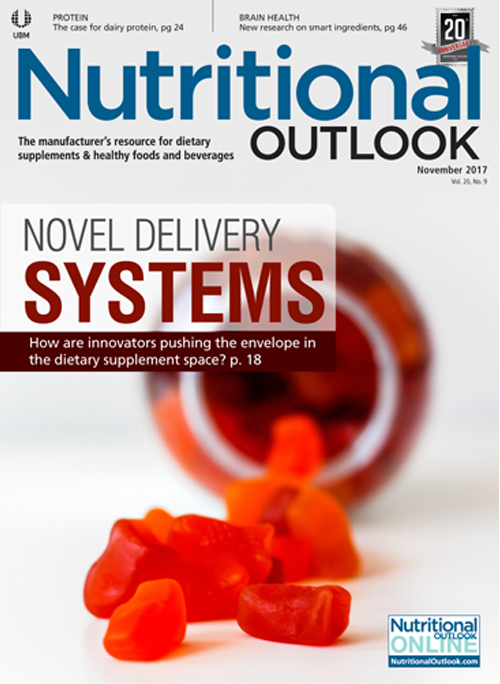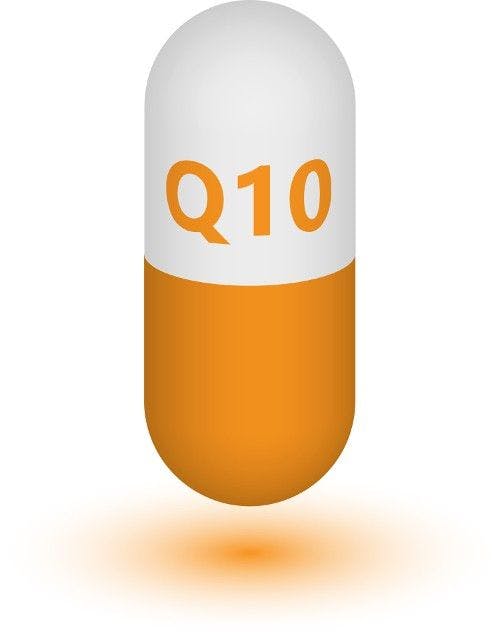Innovative New Delivery Systems for Dietary Supplements
Novel supplement delivery systems push regulatory boundaries.
Photo © Shutterstock.com/Sia-James

In the beginning, there were tablets. And, they were good…for the most part. But for users who found them unpalatable, difficult to swallow, or just-plain boring, they left a lot to be desired. So, dietary supplement developers said, “Let there be better delivery systems.” And, then there were capsules, gel caps, and soft gels, which considerably improved upon the basic tablet.
Then developers said, “Let there be shots, sprinkles, chews, and gummies,” and these options were even more convenient, appealing, and innovative than what came before. So now that everything from nutrient nanoemulsions to liposomal blends is emerging from R&D labs, we may be witnessing the most exciting delivery advances the dietary supplement space has ever seen.
But: Are they truly supplements?
That’s the question facing industry and regulators as new nutrition platforms push the edges of science, creativity-and the law. How far do those borders reach? Vincent Tricarico, vice president of contract manufacturing at NutraScience Labs (Farmingdale, NY), believes, “We’re still in the very early stages of determining where these new formats end up in terms of regulation.”
And while FDA might counter that we know exactly where the regulations stand, thank you very much, we can all agree that the goal, as Tricarico says, “is to keep the public safe.” So, as we chart this brave new world of supplement delivery systems, caution may be the first commandment.
Challenging Tradition
Despite all the innovations in delivery-system design, formats such as classic capsules, powders, softgels, and tablets-as well as gummies, liquids, and chewables-“remain the most popular supplement delivery systems by far,” Tricarico says.
Missy Lowery, MSc, senior manager of marketing at Capsugel (Morristown, NJ), concurs, noting that all generations-“Millennials, GenXers, Boomers, matures”-still gravitate toward traditional delivery formats. More specifically, she says, 42% of supplement users prefer capsules, while 41% prefer tablets, according to the most recent 2015 Supplements Over-the-Counter Rx Data (SORD) study from NMI.1
But, Mona Liu, brand supervisor of marketing at Sirio Pharma Co., Ltd. (Shanghai, China), says, “While these delivery systems have been successful in the past, they’re facing challenges from innovative delivery systems of the future.”
Why We Innovate
Such challenges are understandable. “Innovation in delivery systems is critical to helping certain individuals meet their needs, preferences, and limitations,” says Douglas “Duffy” MacKay, ND, senior vice president of scientific and regulatory affairs at the Council for Responsible Nutrition (CRN; Washington, DC). Older users can have difficulty swallowing pills; children simply may not like them. Consumers can tire of the same-old supplement vehicles. Even psychology plays a part, as “the traditional tablet and softgel can remind people of medicines or drugs,” Liu adds.
Innovation does more than satisfy consumers, however. It also feeds supplement industry growth. Of course, discovery and development of new supplement ingredients-and new uses for them-account for the bulk of that growth. Differentiating a product via novel delivery is a reasonable means of fending off competition, at least for a while.
Says MacKay, “There are all sorts of reasons to explore different formulas and ingredients in everything from a gummy to a tablet to a capsule to a liquid to a chewable to a wafer”-all of which, he adds, are “well within our regulatory areas.” It’s when exploration starts moving outside those areas that alarms may sound.
No Direction Home
To an industry as captivated by scientific progress as ours, limiting the scope of delivery-system invention can feel a bit like taking away the punchbowl. “There’s the desire to be creative and innovative and to think outside the box, which is such an exciting thing to be part of,” MacKay states. But the flipside of that excitement, he says, is “the tension between the category and the limitations it presents based on the regulations.”
And the “number-one limitation” that the Dietary Supplement Health and Education Act of 1994 imposes is its narrow definition of a dietary supplement: a substance administered orally, swallowed and absorbed through the gastrointestinal tract. “You start getting into inhalables, transdermal patches, nasal sprays, vapes,” MacKay says, “and these just don’t have a home inside of dietary supplements. They can’t change the supplement laws. These just are not dietary supplements.”
Crossing the Line
Consider sublingual products. Vitamin B12 is a prime example of a nutrient for which sublingual administration-wherein drops of the vitamin placed under the tongue are absorbed through blood vessels-is “convenient and important,” MacKay say. Many of the enzymes that help us absorb B12 through the gut weaken and diminish with age.
And though “you can still deliver B12 in a dropper bottle, make it with dietary supplement GMPs, and label it as a supplement,” MacKay continues, “you cannot tell the customer that it’s intended to be absorbed through the blood vessels under the tongue” as opposed to the gut. Only doctors can do that-say, as a treatment for megaloblastic anemia. “So, the question for FDA becomes, ‘Is that appropriate for supplementation, or is that more of a clinical use?’” MacKay says. “And their answer would be clinical. It makes sense from a public health/public policy balance.”
Even wildly popular functional foods can tread into dicey regulatory territory. Several times recently, FDA has warned marketers of melatonin-containing brownies, beverages, and other foods that because their products are conventional foods rather than supplements, the presence of melatonin-an unapproved additive without GRAS status for food use-in their formulations renders them adulterated. Here, too, MacKay thinks “if you peel back the layers of that onion,” FDA’s move “does make some sense.” While an ingredient like melatonin may be “appropriate to put into a dietary supplement labeled, ‘Take one capsule before bedtime, it’s not appropriate just to throw it into some chocolate milk.”
Welcome to Nano-World
Perhaps the arena with the greatest potential for both revolutionizing supplement delivery and attracting FDA’s attention is that of nanoparticles (i.e., those that are 1–100 nanometers in size). Even toxicologists, whose job is to study and understand the adverse effects of chemicals, find the nano-world “probably the most troubling and not-well-defined area” of new product development, says John R. Endres, ND, chief scientific officer, AIBMR Life Sciences (Seattle, WA).
Or, as MacKay puts it, “This is science-fiction stuff.”
Yet, some brands ballyhoo their nano-credentials, promoting products presumably made all the more powerful by the extreme miniaturization of dietary ingredients. The concern, says Endres, is that nano-sized ingredients could pass through the blood–brain and other barriers our bodies have evolved to control what gets inside and into key organs-and not enough research has been conducted to illuminate what happens once they’re there. “So that’s a big issue, one that even major toxicology groups haven’t figured out yet,” Endres says.
Bioavailability is another black box obscuring nanoparticles’ safety. FDA grants ingredients GRAS status based upon common consumption levels generally recognized as safe. But if nanoparticularization makes ingredients that much more bioavailable-which is kind of the point-we no longer know if the levels previously determined to be GRAS continue to be so. “And if you don’t know,” Endres adds, “you have to test it-but if it’s nano, we don’t yet know how to test it.”
Of course, some products claiming to contain nanoparticles really don’t, which adds a troubling layer of misleading labeling. Endres adds that similar safety questions accompany “virtually every delivery form where the whole purpose is to increase ingredient bioavailability and get more into the system.” So, his message to marketers is, “Do your homework because the main concern is safety. That’s always the main concern.”
Oldies and Goodies
MacKay agrees that consumer safety is the top priority: “That’s the bottom line. If you set aside the marketing excitement, these are fairly rational models for public health and public safety.”
And here’s the great part: They don’t have to squelch innovation. In fact, they can pay unexpected dividends. For while developers tread cautiously with respect new delivery formats, they continue improving the formats already in use-and in accordance with FDA regulations. As MacKay says, “Some of the really cool stuff is the simple stuff.”
For example, industry “waited for years” for vegan gel caps that weren’t brittle and could protect labile ingredients like fish oil. “There were multiple generations of failures in that area where they were too stiff or leaked or had other drawbacks,” MacKay says. “So, innovation had to continue.”
He’s also bullish on “tablets within tablets and capsules within capsules” as a means of making supplement delivery more convenient and personalized. “Compliance is a big piece of this,” he notes. “If you’re going to use supplements regularly, how easy is it to do so?”
Lowery’s company is already making it easier. “Growing consumer interest in multi-combination and multi-release supplements has opened the market for the elegant delivery forms of beads-in-a-capsule and capsule-in-a-capsule DUOCAPS,” she says. Such platforms play to the “less-is-more” trend by combining two or more supplements into one capsule that minimizes the number of supplements a consumer takes while also giving them more bang for their delivery-system buck. “Release profiles can be time and include targeted delivery as well as sustained delivery for optimal effect,” she adds.
Lipid multiparticulate (LMP) technology can also boost ingredient effectiveness by modifying release and enhancing bioavailability. LMPs are microspheres ranging in size from 50 to 300 µm, and each particle is formulated to contain a measured micro-dose of actives-from botanicals and vitamins to amino acids and more. Because of their excellent flow properties, Lowery says, the particles are suitable for a broad range of formats, including textured powder blends for scoop, sachet, or stick delivery; powder-filled capsules; sprinkle capsules and capsules-within-capsules. She states, “The ability to precisely deliver a metered dose of actives combined with the controlled particle size of LMPs can lead to improved gut distribution.”
All in Good Taste
The particles’ “advanced precision dosing and floating microspheres” also feel smooth on the palate “rather than crunchy to the teeth,” Lowery adds. Even better, they “improve the consumer experience by masking the taste of bitter ingredients.”
And, that’s an important point-for as whiz-bang as supplement delivery systems may get, palatability remains a major requirement for success. Take the ever-popular gummy as an example. “It’s difficult to balance both the taste and texture when developing multivitamin gummies-especially for those that contain high levels of minerals,” Sirio’s Liu says. Dose uniformity-particularly in gummies containing micronutrients, oil-soluble substances, and minerals-also requires special processing. And with process temperatures exceeding 210 °F, moisture contents above 10% and a pH that hovers around 3, the gummy platform does not promote active-ingredient stability.
But Liu’s team has focused on “bringing better flavor to gummies and masking their unpleasant bitterness, metal and fishy notes” even as the gummies include more active ingredient. They’ve also developed an accelerated stability study method that, in three months’ time, can evaluate product performance predictive of 18–24 months of shelf life. With gummy multivitamins generating 7.5% of the $6-billion US multivitamin market in 2016, Liu says, such improvements are money in the bank.
And they’re no less exciting than any nanoemulsion, vitamin vape, or mood-altering brownie out there. “Every day, we learn how to make formulations more stable and effective within these ‘old’ standard delivery systems,” Tricarico says. “Consumers are familiar with these systems and remain comfortable using them.”
Also read:
Capsule Filling: Quality by Design
Dietary Supplement Capsules Challenges and Trends
References:
- NMI, “2015 Global Supplements/OTC/Rx Consumer Research Study.” http://www.nmisolutions.com/opt/studies/NMI-2015-Global-SORD-Research-Study.pdf. Accessed October 4, 2017.

Newsletter
From ingredient science to consumer trends, get the intel you need to stay competitive in the nutrition space—subscribe now to Nutritional Outlook.
Radicle Science has launched Radicle Discovery Gen 2
July 22nd 2025Radicle Science announced the launch of the latest version of its proof-as-a-service platform, Radicle Discovery Gen 2, which combines rigorous clinical trials, AI, data, and crowdsourcing to validate the effects of natural products across diverse populations.

.png&w=3840&q=75)

.png&w=3840&q=75)



.png&w=3840&q=75)



.png&w=3840&q=75)



















